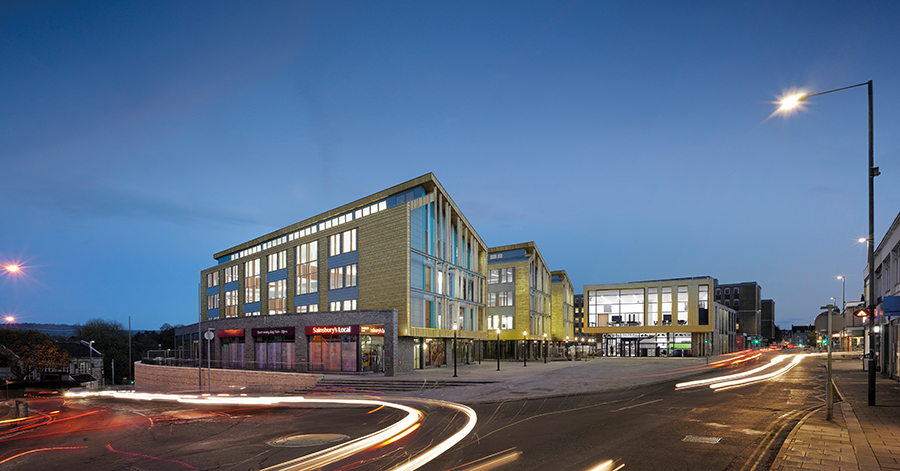Encouraging economic growth across the UK is one of the biggest challenges facing the Government today – but it also offers a unique opportunity. Karle Burford, Director at leading architecture and building consultancy practice AHR, explains how local authorities can maximise the impact of regeneration projects.
AHR
Following Theresa May’s announcement of the Stronger Towns Fund, £1.6bn has been pledged to deprived towns across the country. This follows the removal of the borrowing cap on the Housing Revenue Account and both changes have granted local authorities greater access to funds at uniquely competitive rates.
Local authorities are now in a strong position to unlock land that has previously been unavailable. Problem sites that may not have been commercially viable for private sector developers can now be regenerated in collaboration with local authorities and deliver significant benefits for communities. One great example of this is the London Borough of Havering’s £1bn joint venture with Wates Residential to regenerate 12 existing council estates.
The scheme will see the council’s current stock of 966 homes replaced by 3112 new homes of mixed tenure, increasing council rented accommodation in the area by 70%. It will also double the amount of affordable housing across the 12 estates, demonstrating the potential these partnerships can hold.
Local authorities are also uniquely well-placed to prioritise public realm to maximise community benefits and this is critical from a placemaking perspective. Creating well-used public spaces not only increases the vibrancy of a town centre but can also have a host of other benefits. Properly planned public space that is well lit and open can reduce anti-social behaviour for example, while appropriate street furniture or an art installation can increase dwell time and encourage greater interaction and engagement.
The important thing here is to take a collaborative, bottom-up approach to regeneration. The public and private sector are increasingly working together to create developments directly with local communities. This is the most effective way to ensure a regeneration project will breathe new life back into a town centre.
A future-proof solution
A strategic masterplan should consider the long-term use of a project if it is to be effective. It is only by accounting for existing infrastructure, possible land swaps and diverse uses for both new and existing buildings for example, that local authorities and developers can create communities that will properly serve the residents of tomorrow.
It is also essential to take a flexible approach to development to cater for future demands and economic fluctuations. For example, there has recently been an increase in buildings being occupied by small pop ups before they are even finished, while developers test ideas and think creatively about how a space will best be used. This tactic has proved to be extremely valuable; however, it requires a long-term, iterative approach to a project.
Diversity of real estate is a huge driver of economic growth and is vital to secure sustained prosperity for a town centre. Avoiding single-ownership and encouraging interaction between education, retail, leisure and public realm is key to building growing centres with robust economies.
Finally, the dynamics of the market must be carefully considered to future-proof regeneration projects. For example, the retail industry has transformed significantly in recent years and our high streets are at the forefront of these changes. Local authorities need to be receptive to these market trends if they want to plan for economic prosperity over the long term.
Creating vibrant communities
Changes in modern lifestyles are impacting the needs and requirements of local communities. Whereas once a town was designed with a retail centre, commercial district and housing developments in separate areas, increasingly we want to live in places that combine them all. A modern vibrant community is typically mixed-use, densely populated and incorporates layers of use that complement each other.
Developers and architects need to think beyond an individual building to assess how a holistic project can form the basis of a more significant change to a town centre. A good example of this was the Keynsham Civic Centre and Library & Information Service project delivered by AHR. For this scheme in the heart of Keynsham town centre, strong placemaking principles helped to deliver a mixed-use development with over 50% of the site dedicated to public space.
This project was driven by the council’s requirement for 68,000ft² of new office space, however AHR was able to deliver something far beyond this by focussing on community value. Two offices were consolidated into one, enhancing the collaborative working potential between council departments. In addition to this, pedestrian links, car parking and a new library were delivered alongside 20,000ft² of retail on the ground floor of the office buildings. The new site has been designed to maximise active building frontages, with outside seating used to connect the building with surrounding public realm. This public space comprises a new central square in which markets and events can be held – delivering value for the whole community.
Sustainability was also a key consideration to the long-term view of the regeneration project. To future-proof the development’s legacy, the project at Keynsham incorporated natural ventilation and an energy-efficient cross-laminated timber frame, embracing the energy standards of the future.
Although it was the local authority’s office space requirement that sparked the requirement for this project, by thinking beyond this scope we were able to deliver a wide-reaching regeneration project that added a great deal more value to the local community.
Fulfilling potential
The recent funding changes have sparked a wave of new regeneration projects across the UK. It is now down to local authorities to unlock the value that this can offer, both in economic and societal terms.
By forging intelligent partnerships, prioritising public realm and taking a long-term approach to strategic masterplanning, local authorities can reimagine old town centres to deliver thriving, vibrant communities.









